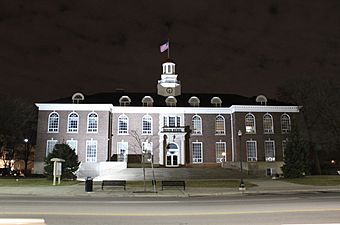Dearborn City Hall Complex facts for kids
Quick facts for kids |
|
|
Dearborn City Hall Complex
|
|
 |
|
| Location | 13615 Michigan Ave Dearborn, Michigan |
|---|---|
| Built | 1921, 1929 |
| Architect | Marcus Burrowes, Fry and Kasurin |
| Architectural style | Colonial Revival, Georgian Revival |
| NRHP reference No. | 14000513 |
| Added to NRHP | August 25, 2014 |
The Dearborn City Hall Complex is a group of three important government buildings. You can find them at 13615 Michigan Avenue in Dearborn, Michigan. This complex includes the original Dearborn City Hall, built in 1921. It also has the Police and Municipal Courts Building from 1929. Plus, there's a newer office and auditorium addition from 1981. This historic complex was added to the National Register of Historic Places in 2014.
Contents
Discovering Dearborn City Hall's Past
The area where Dearborn City Hall stands today was first settled in 1837. It was known as Springwells. In 1921, Springwells officially became a village. That same year, the village hired architect Marcus Burrowes. He designed the Springwells Municipal Building, which is now the City Hall.
Burrowes imagined a whole group of connected buildings. While his full plan wasn't completed, more buildings were added in the 1920s. This created the government complex we see today.
How Springwells Grew into Dearborn
Springwells grew very quickly. This was thanks to the nearby Ford River Rouge Complex. Many workers moved to the area, bringing more money and growth. A few years later, in 1925, Springwells became a city. It also changed its name to Fordson.
More buildings were added around this time. In 1929, the City of Fordson joined with the Village of Dearborn. They also joined with Dearborn Township. Together, they formed the larger City of Dearborn. That same year, the Police and Municipal Courts Building was added to the complex.
The Dearborn City Hall became the main place for city government. Henry Ford's cousin, Clyde M. Ford, was the first mayor of the new Dearborn. He served from 1929 to 1935. Later, Orville L. Hubbard was mayor for a long time, from 1942 to 1978. In 1979, some older, smaller buildings were taken down. This made space for the 1981 addition.
Exploring the City Hall Complex Buildings
The Dearborn City Hall Complex covers almost an entire city block. It is located along Michigan Avenue. The complex has three main parts. There's the 1921 Dearborn City Hall, facing Michigan Avenue. Then there's the 1929 Police and Municipal Courts Building. It faces Maple Street. Finally, the 1981 office and auditorium addition connects the two older buildings. The area also includes a park and a war memorial.
The Historic Dearborn City Hall Building
The Dearborn City Hall is a two-and-a-half-story building. It is made of red brick with a limestone base. It has a sloped roof. Marcus Burrowes designed it in 1921 in the Georgian Revival style. The building is about 300 feet (91 meters) long. Its main entrance is in the middle.
The front of the building has five sections. The ends of the building stick out a bit. The windows are different sizes and shapes. Some are square, and some have rounded tops. The roof is covered with clay tiles. A tall, decorative tower, called a cupola, sits in the center.
Inside, the building has a long hallway. The floors are made of terrazzo and marble. The walls have marble along the bottom. A grand marble staircase connects all the floors. Most of the rooms are offices and storage. Many parts of the inside were updated in 1981.
The Police and Municipal Courts Building
The Police and Municipal Courts Building is also two-and-a-half stories tall. It is made of red brick. John Kasurin designed it in 1929 in the Colonial Revival style. The building is about 250 feet (76 meters) long.
The main entrance is made of limestone. It has tall double doors with a large glass window. There are two windows next to the doors. Four stone pillars support a stone ledge above the entrance. The windows in this building are also different sizes.
The inside of this building is much like the City Hall. It has a central hallway with terrazzo and marble floors. A grand marble staircase is in the main lobby. Most of the rooms are offices and storage. Like the City Hall, many of these spaces were updated in 1981.
The Concourse Addition
The Concourse Addition was built in 1981. It is mostly underground. This addition connects the two older buildings. It provides extra office space, an auditorium, and parking.

